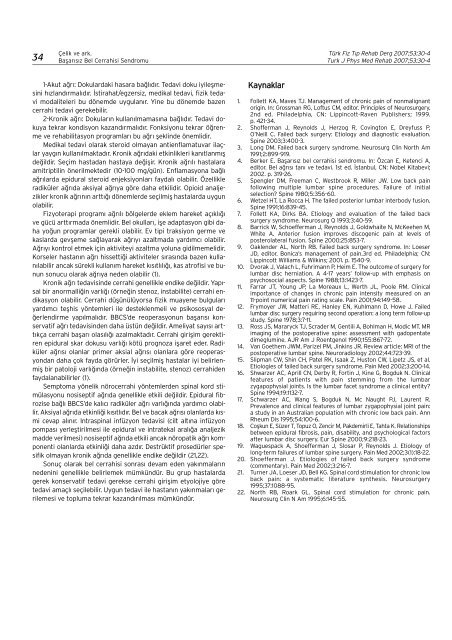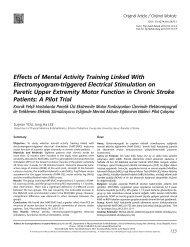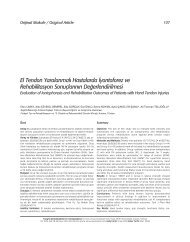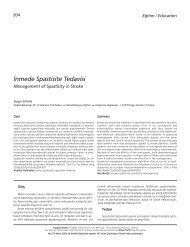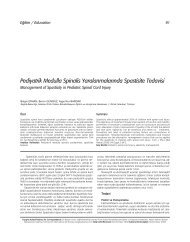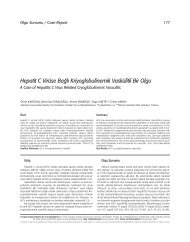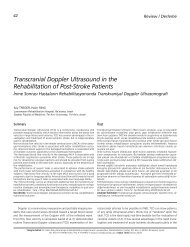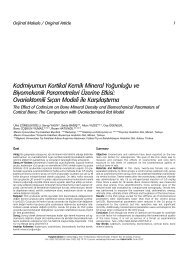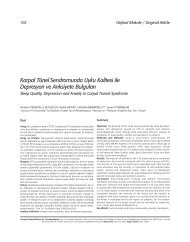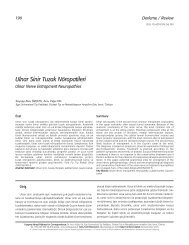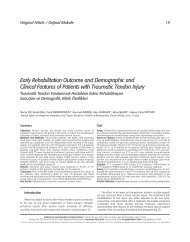Baflar›s›z Bel Cerrahisi Sendromu: Nedenleri, Tan› ve Tedavi
Baflar›s›z Bel Cerrahisi Sendromu: Nedenleri, Tan› ve Tedavi
Baflar›s›z Bel Cerrahisi Sendromu: Nedenleri, Tan› ve Tedavi
You also want an ePaper? Increase the reach of your titles
YUMPU automatically turns print PDFs into web optimized ePapers that Google loves.
34<br />
Çelik <strong>ve</strong> ark.<br />
<strong>Baflar›s›z</strong> <strong>Bel</strong> <strong>Cerrahisi</strong> <strong>Sendromu</strong><br />
1-Akut a¤r›: Dokulardaki hasara ba¤l›d›r. <strong>Tedavi</strong> doku iyileflmesini<br />
h›zland›rmal›d›r. ‹stirahat/egzersiz, medikal tedavi, fizik tedavi<br />
modaliteleri bu dönemde uygulan›r. Yine bu dönemde bazen<br />
cerrahi tedavi gerekebilir.<br />
2-Kronik a¤r›: Dokular›n kullan›lmamas›na ba¤l›d›r. <strong>Tedavi</strong> dokuya<br />
tekrar kondisyon kazand›rmal›d›r. Fonksiyonu tekrar ö¤renme<br />
<strong>ve</strong> rehabilitasyon programlar› bu a¤r› fleklinde önemlidir.<br />
Medikal tedavi olarak steroid olmayan antienflamatuvar ilaçlar<br />
yayg›n kullan›lmaktad›r. Kronik a¤r›daki etkinlikleri kan›tlanm›fl<br />
de¤ildir. Seçim hastadan hastaya de¤iflir. Kronik a¤r›l› hastalara<br />
amitriptilin önerilmektedir (10-100 mg/gün). Enflamasyona ba¤l›<br />
a¤r›larda epidural steroid enjeksiyonlar› faydal› olabilir. Özellikle<br />
radiküler a¤r›da aksiyal a¤r›ya göre daha etkilidir. Opioid analjezikler<br />
kronik a¤r›n›n artt›¤› dönemlerde seçilmifl hastalarda uygun<br />
olabilir.<br />
Fizyoterapi program› a¤r›l› bölgelerde eklem hareket aç›kl›¤›<br />
<strong>ve</strong> gücü artt›rmada önemlidir. <strong>Bel</strong> okullar›, ifle adaptasyon gibi daha<br />
yo¤un programlar gerekli olabilir. Ev tipi traksiyon germe <strong>ve</strong><br />
kaslarda gevfleme sa¤layarak a¤r›y› azaltmada yard›mc› olabilir.<br />
A¤r›y› kontrol etmek için aktiviteyi azaltma yoluna gidilmemelidir.<br />
Korseler hastan›n a¤r› hissetti¤i aktiviteler s›ras›nda bazen kullan›labilir<br />
ancak sürekli kullan›m hareket k›s›tl›l›¤›, kas atrofisi <strong>ve</strong> bunun<br />
sonucu olarak a¤r›ya neden olabilir (1).<br />
Kronik a¤r› tedavisinde cerrahi genellikle endike de¤ildir. Yap›sal<br />
bir anormalli¤in varl›¤› (örne¤in stenoz, instabilite) cerrahi endikasyon<br />
olabilir. Cerrahi düflünülüyorsa fizik muayene bulgular›<br />
yard›mc› teflhis yöntemleri ile desteklenmeli <strong>ve</strong> psikososyal de-<br />
¤erlendirme yap›lmal›d›r. BBCS’de reoperasyonun baflar›s› konservatif<br />
a¤r› tedavisinden daha üstün de¤ildir. Ameliyat say›s› artt›kça<br />
cerrahi baflar› olas›l›¤› azalmaktad›r. Cerrahi giriflim gerektiren<br />
epidural skar dokusu varl›¤› kötü prognoza iflaret eder. Radiküler<br />
a¤r›s› olanlar primer aksial a¤r›s› olanlara göre reoperasyondan<br />
daha çok fayda görürler. ‹yi seçilmifl hastalar iyi belirlenmifl<br />
bir patoloji varl›¤›nda (örne¤in instabilite, stenoz) cerrahiden<br />
faydalanabilirler (1).<br />
Semptoma yönelik nörocerrahi yöntemlerden spinal kord stimülasyonu<br />
nosiseptif a¤r›da genellikle etkili de¤ildir. Epidural fibrozise<br />
ba¤l› BBCS’de kal›c› radiküler a¤r› varl›¤›nda yard›mc› olabilir.<br />
Aksiyal a¤r›da etkinli¤i k›s›tl›d›r. <strong>Bel</strong> <strong>ve</strong> bacak a¤r›s› olanlarda k›smi<br />
cevap al›n›r. Intraspinal infüzyon tedavisi (cilt alt›na infüzyon<br />
pompas› yerlefltirilmesi ile epidural <strong>ve</strong> intratekal aral›¤a analjezik<br />
madde <strong>ve</strong>rilmesi) nosiseptif a¤r›da etkili ancak nöropatik a¤r› komponenti<br />
olanlarda etkinli¤i daha azd›r. Destrüktif prosedürler spesifik<br />
olmayan kronik a¤r›da genellikle endike de¤ildir (21,22).<br />
Sonuç olarak bel cerrahisi sonras› devam eden yak›nmalar›n<br />
nedenini genellikle belirlemek mümkündür. Bu grup hastalarda<br />
gerek konservatif tedavi gerekse cerrahi giriflim etyolojiye göre<br />
tedavi amaçl› seçilebilir. Uygun tedavi ile hastan›n yak›nmalar› gerilemesi<br />
<strong>ve</strong> topluma tekrar kazand›r›lmas› mümkündür.<br />
Kaynaklar<br />
Türk Fiz T›p Rehab Derg 2007;53:30-4<br />
Turk J Phys Med Rehab 2007;53:30-4<br />
1. Follett KA, Ma<strong>ve</strong>s TJ. Management of chronic pain of nonmalignant<br />
origin. In: Grossman RG, Loftus CM, editor. Principles of Neurosurgery.<br />
2nd ed. Philadelphia, CN: Lippincott-Ra<strong>ve</strong>n Publishers; 1999.<br />
p. 421-34.<br />
2. Shofferman J, Reynolds J, Herzog R, Covington E, Dreyfuss P,<br />
O’Neill C. Failed back surgery: Etiology and diagnostic evaluation.<br />
Spine 2003;3:400-3.<br />
3. Long DM. Failed back surgery syndrome. Neurosurg Clin North Am<br />
1991;2:899-919.<br />
4. Berker E. <strong>Baflar›s›z</strong> bel cerrahisi sendromu. In: Özcan E, Ketenci A,<br />
editor. <strong>Bel</strong> a¤r›s› tan› <strong>ve</strong> tedavi. 1st ed. ‹stanbul, CN: Nobel Kitabevi;<br />
2002. p. 319-26.<br />
5. Spengler DM, Freeman C, Westbrook R, Miller JW. Low back pain<br />
following multiple lumbar spine procedures. Failure of initial<br />
selection? Spine 1980;5:356-60.<br />
6. Wetzel HT, La Rocca H. The failed posterior lumbar interbody fusion.<br />
Spine 1991;16:839-45.<br />
7. Follett KA, Dirks BA. Etiology and evaluation of the failed back<br />
surgery syndrome. Neurosurg Q 1993;3:40-59.<br />
8. Barrick W, Schoefferman J, Reynolds J, Goldwhaite N, McKeehen M,<br />
White A. Anterior fusion impro<strong>ve</strong>s discogenic pain at le<strong>ve</strong>ls of<br />
posterolateral fusion. Spine 2000;25:853-7.<br />
9. Oaklender AL, North RB. Failed back surgery syndrome. In: Loeser<br />
JD, editor. Bonica’s management of pain.3rd ed. Philadelphia; CN:<br />
Lippincott Williams & Wilkins; 2001. p. 1540-9.<br />
10. Dvorak J, Valach L, Fuhrimann P, Heim E. The outcome of surgery for<br />
lumbar disc herniation. A 4-17 years’ follow-up with emphasis on<br />
psychosocial aspects. Spine 1988;13:1423-7.<br />
11. Farrar JT, Young JP, La Moreaux L, Werth JL, Poole RM. Clinical<br />
importance of changes in chronic pain intensity measured on an<br />
11-point numerical pain rating scale. Pain 2001;94:149-58.<br />
12. Frymoyer JW, Matteri RE, Hanley EN, Kuhlmann D, Howe J. Failed<br />
lumbar disc surgery requiring second operation: a long term follow-up<br />
study. Spine 1978;3:7-11.<br />
13. Ross JS, Mararyck TJ, Scrader M, Gentili A, Bohlman H, Modic MT. MR<br />
imaging of the postoperati<strong>ve</strong> spine: assessment with gadopentate<br />
dimeglumine. AJR Am J Roentgenol 1990;155:867-72.<br />
14. Van Goethem JWM, Parizel PM, Jinkins JR. Review article: MRI of the<br />
postoperati<strong>ve</strong> lumbar spine. Neuroradiology 2002;44:723-39.<br />
15. Slipman CW, Shin CH, Patel RK, Isaak Z, Huston CW, Lipetz JS, et al.<br />
Etiologies of failed back surgery syndrome. Pain Med 2002;3:200-14.<br />
16. Shwarzer AC, Aprill CN, Derby R, Fortin J, Kine G, Bogduk N. Clinical<br />
features of patients with pain stemming from the lumbar<br />
zygapophysial joints. Is the lumbar facet syndrome a clinical entity?<br />
Spine 1994;19:1132-7.<br />
17. Schwarzer AC, Wang S, Bogduk N, Mc Naught PJ, Laurent R.<br />
Prevalence and clinical features of lumbar zygapophysial joint pain:<br />
a study in an Australian population with chronic low back pain. Ann<br />
Rheum Dis 1995;54:100-6.<br />
18. Coflkun E, Süzer T, Topuz O, Zencir M, Pakdemirli E, Tahta K. Relationships<br />
between epidural fibrosis, pain, disability, and psychological factors<br />
after lumbar disc surgery. Eur Spine 2000;9:218-23.<br />
19. Waguespack A, Shoefferman J, Slosar P, Reynolds J. Etiology of<br />
long-term failures of lumbar spine surgery. Pain Med 2002;3(1):18-22.<br />
20. Shoefferman J. Etiologies of failed back surgery syndrome<br />
(commentary). Pain Med 2002;3:216-7.<br />
21. Turner JA, Loeser JD, <strong>Bel</strong>l KG. Spinal cord stimulation for chronic low<br />
back pain: a systematic literature synthesis. Neurosurgery<br />
1995;37:1088-95.<br />
22. North RB, Roark GL. Spinal cord stimulation for chronic pain.<br />
Neurosurg Clin N Am 1995;6:145-55.


